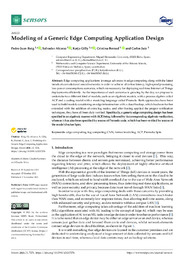Por favor, use este identificador para citar o enlazar este ítem:
https://hdl.handle.net/11000/35401Registro completo de metadatos
| Campo DC | Valor | Lengua/Idioma |
|---|---|---|
| dc.contributor.author | Gilly, Katja | - |
| dc.contributor.author | Roig, Pedro Juan | - |
| dc.contributor.author | Alcaraz, Salvador | - |
| dc.contributor.author | Bernad, Cristina | - |
| dc.contributor.author | Juiz, Carlos | - |
| dc.contributor.other | Departamentos de la UMH::Ingeniería de Computadores | es_ES |
| dc.date.accessioned | 2025-01-28T13:48:47Z | - |
| dc.date.available | 2025-01-28T13:48:47Z | - |
| dc.date.created | 2021 | - |
| dc.identifier.citation | Sensors | es_ES |
| dc.identifier.issn | 1424-8220 | - |
| dc.identifier.uri | https://hdl.handle.net/11000/35401 | - |
| dc.description.abstract | Edge computing applications leverage advances in edge computing along with the latest trends of convolutional neural networks in order to achieve ultra-low latency, high-speed processing, low-power consumptions scenarios, which are necessary for deploying real-time Internet of Things deployments efficiently. As the importance of such scenarios is growing by the day, we propose to undertake two different kind of models, such as an algebraic models, with a process algebra called ACP and a coding model with a modeling language called Promela. Both approaches have been used to build models considering an edge infrastructure with a cloud backup, which has been further extended with the addition of extra fog nodes, and after having applied the proper verification techniques, they have all been duly verified. Specifically, a generic edge computing design has been specified in an algebraic manner with ACP, being followed by its corresponding algebraic verification, whereas it has also been specified by means of Promela code, which has been verified by means of the model checker Spin. | es_ES |
| dc.format | application/pdf | es_ES |
| dc.format.extent | 29 | es_ES |
| dc.language.iso | eng | es_ES |
| dc.publisher | MDPI | es_ES |
| dc.relation.ispartofseries | 21 | es_ES |
| dc.relation.ispartofseries | 21 | es_ES |
| dc.rights | info:eu-repo/semantics/openAccess | es_ES |
| dc.rights | Attribution-NonCommercial-NoDerivatives 4.0 Internacional | * |
| dc.rights.uri | http://creativecommons.org/licenses/by-nc-nd/4.0/ | * |
| dc.subject | edge computing | es_ES |
| dc.subject | fog computing | es_ES |
| dc.subject | CNN | es_ES |
| dc.subject | formal modeling | es_ES |
| dc.subject | ACP | es_ES |
| dc.subject | Promela | es_ES |
| dc.subject | Spin | es_ES |
| dc.subject.other | CDU::6 - Ciencias aplicadas::62 - Ingeniería. Tecnología | es_ES |
| dc.title | Modeling of a Generic Edge Computing Application Design | es_ES |
| dc.type | info:eu-repo/semantics/article | es_ES |
| dc.relation.publisherversion | https://doi.org/10.3390/s21217276 | es_ES |

Ver/Abrir:
sensors-21-07276-v2.pdf
2,21 MB
Adobe PDF
Compartir:
 La licencia se describe como: Atribución-NonComercial-NoDerivada 4.0 Internacional.
La licencia se describe como: Atribución-NonComercial-NoDerivada 4.0 Internacional.
.png)